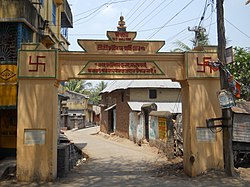
Bolpur is a city and a municipality in Birbhum district in the state of West Bengal, India. It is the headquarters of the Bolpur subdivision. Bolpur municipal area includes Santiniketan. The city is known as a cultural and educational hub of West Bengal. The city is under the jurisdiction of Bolpur and Santiniketan Police station. Bolpur is the largest and most populous city in Birbhum district and 28th most populous city in West Bengal. Located on the banks of Ajay River and Kopai River, Bolpur has been a major human settlement. It is 150 km north of Kolkata and is famous for Visva Bharati, the University set up by the Nobel laureate poet Rabindranath Tagore.
Labhpur is a census town in Labpur CD block in Bolpur subdivision of Birbhum district in the Indian state of West Bengal. It is known to the outside world as the native place of Tarashankar Bandopadhyay and one of the 51 Shakti Peethas.
Kirnahar is a village in Nanoor CD block in Bolpur subdivision of Birbhum district in the Indian state of West Bengal.
Nanoor massacre refers to the massacre of eleven landless labourers allegedly by CPI(M) activists in Suchpur, near Nanoor and under Nanoor police station, in Birbhum district in the Indian state of West Bengal, on July 27, 2000.
Ilambazar is a census town, with a police station, in Ilambazar CD block in Bolpur subdivision of Birbhum district in the Indian state of West Bengal.

Bolpur Subdivision is an administrative subdivision of Birbhum district in the state of West Bengal, India.
Gonna Serandi is a village in Ketugram I CD block in Katwa subdivision of Purba Bardhaman district, West Bengal, India. The village lies on the Purba Bardhaman-Birbhum border and some parts of the village lies in Birbhum district, named as Atgram, Dhapdhara & Chak Atgram.
Jaydev Kenduli is a village and gram panchayat in Ilambazar community development block in Bolpur subdivision of Birbhum District in the Indian state of West Bengal. It is believed by many to be the birthplace of Jayadeva, an issue that is still debated by scholars. It has developed as a religious centre with many temples and ashramas (hermitages). An annual fair, popular as baul fair, is organized on the occasion of Makar Sankranti.

Kankalitala is a temple town in Bolpur Sriniketan CD block in Bolpur subdivision of Birbhum district in the Indian state of West Bengal.
Sriniketan is a neighbourhood of Surul in Bolpur subdivision of Birbhum district in the Indian state of West Bengal. It is adjacent to Santiniketan and houses the second campus of Visva-Bharati University. The Palli Samgathana Vibhag and Palli Siksha Bhavana are located in west bengal
Raipur is a village under Raipur–Supur gram panchayat of Bolpur Sriniketan block in Bolpur subdivision of Birbhum district in the Indian state of West Bengal.

Surul is a census town in Bolpur Sriniketan CD block in Bolpur subdivision of Birbhum district in the Indian state of West Bengal.
Khustigiri is a village in Ilambazar community development block in Bolpur subdivision of Birbhum District in the Indian state of West Bengal. It is 25 kilometres (16 mi) from Suri.
Nanoor is an assembly constituency in Birbhum district in the Indian state of West Bengal. It is reserved for scheduled castes.
Chhatna is a village and a gram panchayat in the Chhatna CD block in the Bankura Sadar subdivision of the Bankura district in the state of West Bengal, India.
Ketugram is a village in Ketugram II CD block in Katwa subdivision of Purba Bardhaman district in the state of West Bengal, India.

Nanoor is a community development block that forms an administrative division in Bolpur subdivision of Birbhum district in the Indian state of West Bengal.
Khujutipara is a village in Nanoor CD block in Bolpur subdivision of Birbhum district.
Parota is a census town in Nanoor CD block in Bolpur subdivision of Birbhum district.

Supur is a village under Raipur-Supur gram panchayat in Bolpur Sriniketan CD block in Bolpur subdivision of Birbhum district, West Bengal, India.













